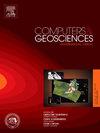Automatic recognition of debris rock lithology based on unsupervised semantic segmentation
IF 4.2
2区 地球科学
Q1 COMPUTER SCIENCE, INTERDISCIPLINARY APPLICATIONS
引用次数: 0
Abstract
Accurate identification of lithology in debris rock is crucial for optimizing resource development in geological exploration and the oil and gas industry. The traditional approach, which depends on experts manually analyzing remote sensing images, is not only laborious but also vulnerable to subjectivity. In contrast, supervised learning, although highly automated, is limited by the need for large-scale annotated data and sample imbalance issues. In our proposed unsupervised semantic segmentation method, automatic segmentation of rock images not only improves the efficiency and accuracy of lithology recognition but also reduces human errors, providing an effective solution for automated lithology analysis. We collected a large amount of debris rock data from the Qingshuihe-Karazha using remote sensing satellites and used an improved FCN network combined with super-pixel segmentation to generate pseudo labels instead of manual labeling, achieving unsupervised segmentation. We compared this method with traditional K-Means, ISODATA, and CNN + K-Means pseudo-label generation methods. By calculating evaluation metrics named ARE, AMI, and FMI, which are used for unsupervised semantic segmentation methods, we found that our method maintains high consistency and robustness in various image sizes, especially when the size of debris rock images is large, and its stability is superior. At the same time, we addressed the boundary issues caused by the need for block division in the lithology image of ultra-large debris rocks, as well as the problem of a large number of similar blocks after block division. The efficiency and accuracy of this method in lithology identification were determined, providing more convenient and efficient data processing methods for geological researchers.
基于无监督语义分割的碎屑岩岩性自动识别
碎屑岩岩性的准确识别是地质勘探和油气工业资源优化开发的关键。传统的方法依赖于专家对遥感图像进行人工分析,不仅费时费力,而且容易受到主观性的影响。相比之下,监督学习虽然高度自动化,但受到大规模注释数据和样本不平衡问题的限制。在我们提出的无监督语义分割方法中,岩石图像的自动分割不仅提高了岩性识别的效率和准确性,而且减少了人为错误,为岩性自动化分析提供了有效的解决方案。利用遥感卫星采集了大量清水河-卡拉扎断裂带岩屑数据,采用改进的FCN网络结合超像素分割方法生成伪标签代替人工标记,实现了无监督分割。我们将该方法与传统的K-Means、ISODATA和CNN + K-Means伪标签生成方法进行了比较。通过对用于无监督语义分割方法的ARE、AMI和FMI评价指标的计算,我们发现该方法在各种图像尺寸下都保持了较高的一致性和鲁棒性,特别是当碎片岩石图像尺寸较大时,其稳定性优越。同时解决了超大型碎屑岩岩性图像中由于需要进行块体划分而产生的边界问题,以及块体划分后出现大量相似块体的问题。确定了该方法在岩性识别中的效率和准确性,为地质研究人员提供了更方便、高效的数据处理方法。
本文章由计算机程序翻译,如有差异,请以英文原文为准。
求助全文
约1分钟内获得全文
求助全文
来源期刊

Computers & Geosciences
地学-地球科学综合
CiteScore
9.30
自引率
6.80%
发文量
164
审稿时长
3.4 months
期刊介绍:
Computers & Geosciences publishes high impact, original research at the interface between Computer Sciences and Geosciences. Publications should apply modern computer science paradigms, whether computational or informatics-based, to address problems in the geosciences.
 求助内容:
求助内容: 应助结果提醒方式:
应助结果提醒方式:


